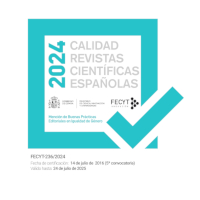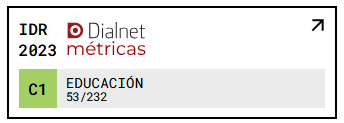Disciplinary measures as a predictor of violent behavior in the school
DOI:
https://doi.org/10.18172/con.3506Keywords:
School discipline, violence, school context, teacherAbstract
A study of the evolution of the lack of discipline in a period of three school years is presented to prevent violent actions in the educational context. We analyzed 204 faults committed by students from first to fifth grade from a mixed method research approach. The correlation analysis (Pr>F 0.037) is significant with the variable that indicates that students of the masculine gender attack mainly their peers. The results show that the main faults committed have been serious faults (50.5%) such as assaulting a partner and disrespecting a teacher. In conclusion, the infractions decrease in the application of disciplinary measures in the school context.Downloads
References
Berger, C., Karimpour, R. y Rodkin, P. (2008). Bullies and victims at school: Perspectives and strategies for primary prevention. En: Tomas W. Miller (Ed.), School violence and primary prevention. New York, Springer, pp. 295-322.
Brophy-Herb, H. E., Lee, R. E., Nievar, M. A. y Stollak, G. (2007). Preschoolers’ social competence: Relations to family characteristics, teacher behaviors and classroom climate. Journal of Applied Developmental Psychology, 28(2), 134-148. https://doi.org/10.1016/j.appdev.2006.12.004.
Brunstein, A., Marrocco, F., Kleiman, M., Schonfeld, I. y Gould, M. (2007). Bullying, depression, and suicidality in adolescents. J Am Acad Child Adolesc Psychiatry, 46(1), 40-49.
Chang, L. (2004). The Role of Classroom Norms in Contextualizing the Relations of Children’s Social Behaviors to Peer Acceptance. Developmental Psychology, 40(5), 691-702. https://doi.org/10.1037/0012-1649.40.5.691.
Chen, J.-K. y Avi Astor, R. (2010). School Violence in Taiwan: Examining How Western Risk Factors Predict School Violence in an Asian Culture. Journal of Interpersonal Violence, 25(8), 1388-1410. https://doi.org/10.1177/0886260509354576.
Creswell, J. W. L. y Clark, V. P. (2010). Choosing a mixed methods design. En Designing and conducting mixed methods research (pp. 53-106). https://doi.org/1412927927.
Debarbieux, E. y Catherine, B. (2006). Clima y violencia escolar: Un estudio comparativo entre España y Francia. Revista de Educación, 339, 293-315.
Defensor del Pueblo (2007). Violencia escolar: El maltrato entre iguales en la educación secundaria obligatoria 1999-2006. Madrid, Comité Español de UNICEF, Publicaciones de la Oficina del Defensor del Pueblo.
Del Tronco, J. (2013). La violencia en las escuelas secundarias de México. Una exploración de sus dimensiones. México, FLACSO.
Denzin, N. K. (2010). Moments, Mixed Methods, and Paradigm Dialogs. Qualitative Inquiry, 16(6), 419-427. https://doi.org/10.1177/1077800410364608.
Díaz-Aguado Jalón, M. J. (2005). La violencia entre iguales en la adolescencia y su prevención desde la Escuela. Psicothema, 17(4), 449-558.
Evans, C. B. R., Fraser, M. W. y Cotter, K. L. (2014). The effectiveness of school-based bullying prevention programs: A systematic review. Aggression and Violent Behavior, 19(5), 532-544. https://doi.org/10.1016/j.avb.2014.07.004.
Farrell, A. D., Meyer, A. L. y White, K. S. (2001). Evaluation of Responding in Peaceful and Positive Ways (RIPP): A School-Based Prevention Program for Reducing Violence Among Urban Adolescents. Journal of Clinical Child y Adolescent Psychology, 30(4), 451-463. https://doi.org/10.1207/S15374424JCCP3004_02.
Flannery, D. J., Vazsonyi, A. T., Liau, A. K., Guo, S., Powell, K. E., Atha, H., … Embry, D. (2003). Initial behavior outcomes for the PeaceBuilders universal school-based violence prevention program. Developmental Psychology, 39(2), 292-308. https://doi.org/10.1037/0012-1649.39.2.292.
Foshee, V. A., Benefield, T. S., McNaughton Reyes, H. L., Eastman, M., Vivolo-Kantor, A. M., Basile, K. C., … Faris, R. (2016). Examining explanations for the link between bullying perpetration and physical dating violence perpetration: Do they vary by bullying victimization? Aggressive Behavior, 42(1), 66-81. https://doi.org/10.1002/ab.21606.
Furlán, A. (2009). Acerca de la violencia en la escuela. Revista Novedades Educativas, 224, pp. 12-15.
Galand, B., Lecocq, C. y Philippot, P. (2007). School violence and teacher professional disengagement. British Journal of Educational Psychology, 77(2), 465-477. https://doi.org/10.1348/000709906X114571.
Garaigordobil, M. y Oñederra, J. (2010). Inteligencia emocional en las víctimas de acoso escolar y en los agresores. European Journal of Education and Psychology, 3(2), 243-256. https://doi.org/10.1989/ejep.v3i2.63.
Garaigordobil Landazabal, M. y Oñederra, J. A. (2010). Los centros educativos ante el acoso escolar: actuaciones del profesorado, acciones sancionadoras y actividades de acciones sancionadoras y actividades de prevención. Informació Psicològica, 99, 4-18. https://doi.org/10.1017/CBO9781107415324.004.
García-Costoya, M. (2010). Violencia en las escuelas. Un relevamiento desde la mirada de los alumnos. Buenos Aires: Ministerio de Educación.
Gregory, A., Cornell, D., Fan, X., Sheras, P., Shih, T.-H. y Huang, F. (2010). Authoritative school discipline: High school practices associated with lower bullying and victimization. Journal of Educational Psychology, 102(2), 483-496. https://doi.org/10.1037/a0018562.
Hoffman, M. L. (1994). Discipline and internalization. Developmental Psychology, 30(1), 26-28. https://doi.org/10.1037//0012-1649.30.1.26.
Hunter, L., Elias, M. J. y Norris, J. (2001). School-based violence prevention. Journal of School Psychology, 39(2), 161-175. https://doi.org/10.1016/S0022-4405(01)00058-9.
Idu, A. P. y Ojedapo, D. O. (2011). Indiscipline in Secondary Schools: A Cry to All Stakeholders in Education. Proceedings of the 2011 International Conference on Teaching, Learning and Change, (c), 729-735.
Johnson, B., Onwuegbuzie, A. J. y Turner, L. A. (2007). Toward a Definition of Mixed Methods Research. Journal of Mixed Methods Research, 1(2), 112-133. https://doi.org/10.1177/1558689806298224.
Johnson, S. L. (2009). Improving the school environment to reduce school violence: A review of the literature. Journal of School Health, 79(10), 451-465. https://doi.org/10.1111/j.1746-1561.2009.00435.x.
Kinsler, J. (2013). School discipline: A source or salve for the racial achievement gap? International Economic Review, 54(1), 355-383. https://doi.org/10.1111/j.1468-2354.2012.00736.x.
Krskova, H. y Baumann, C. (2017). School discipline, investment, competitiveness and mediating educational performance. International Journal of Educational Management, 31, 293-319. https://doi.org/10.1108/IJEM-05-2016-0099.
Luengo, F. (2006). El Proyecto Atlántida : experiencias para fortalecer el eje escuela, familia y municipio. Revista de Educación, 339, 177-193.
Luiselli, J. K., Putnam, R. F., Handler, M. W. y Feinberg, A. B. (2005). Whole-school positive behaviour support: Effects on student discipline problems and academic performance. Educational Psychology. https://doi.org/10.1080/0144341042000301265.
Maphosa, C. y Mammen, K. J. (2011). How chaotic and unmanageable classrooms have become: Insights into prevalent forms of learner indiscipline in south african schools. Anthropologist, 13(3), 185-193.
Marcus, R. F. (2007). Aggression and Violence in Adolescence. Cambridge: Cambridge University Press. https://doi.org/10.1017/CBO9780511611292.
McKinney, C. M., Caetano, R., Ramisetty-Mikler, S. y Nelson, S. (2009). Childhood Family Violence and Perpetration and Victimization of Intimate Partner Violence: Findings From a National Population-Based Study of Couples. Annals of Epidemiology, 19(1), 25-32. https://doi.org/10.1016/j.annepidem.2008.08.008.
Meirieu, P. (2001). La Opción de educar :ética y pedagogía. Barcelona: Octaedro.
Olweus, D. (2001). Bullying at school: Tackling the problem. OECD Observer, 225, 24-26. https://doi.org/10.1007/978-1-4757-9116-7_5.
Olweus, D. (2006). Conductas de acoso y amenaza entre escolares. Madrid: Morata.
Ortega-Rivera, J., Sánchez-Jiménez, V. y Ortega-Ruiz, R. (2010). Violencia sexual y cortejo juvenil. En Rosario Ortega-Ruiz (Coord.), Agresividad injustificada, bullying y violencia escolar. Madrid: Alianza Editorial, pp. 211-232.
Peter A. Hastie y Siedentop, D. (2006). The classroom ecology paradigm. En The handbook of physical education (p. 838). https://doi.org/10.4135/9781848608009.
Peterson, R. L. y Skiba, R. (2001). Creating School Climates That Prevent School Violence. Clearing House, 74(3), 155-163. https://doi.org/10.1080/10459880009599794.
Piñuel, I. y Oñate, A. (2006). La evaluación y diagnóstico del mobbing o acoso psicológico en la organización: el barómetro Cisneros. Revista de Psicología del Trabajo y de las Organizaciones = Journal of Work and Organizational Psychology, 22(3), 309-332. Recuperado de http://dialnet.unirioja.es/servlet/articulo?codigo=2229701yinfo=resumenyidioma=SPA
Preston, P. (1991). Positive discipline. Administrative Radiology : AR, 10(7), 17-20. https://doi.org/ISBN: 978-974-7522-68-6.
Reeve, J. (2006). Teachers as Facilitators: What Autonomy-Supportive Teachers do and Why their Students Benefit. The Elementary School Journal, 106(3), 225-236.
Reyes-Sánchez, C., Martínez-Ferrer, B. y Moreno, D. (2015). Adolescentes agresores en la escuela. Un análisis desde la perspectiva de género. Feminismo/s, 25, 111-131.
Rimm-Kaufman, S. E., Curby, T. W., Grimm, K. J., Nathanson, L. y Brock, L. L. (2009). The contribution of children’s self-regulation and classroom quality to children’s adaptive behaviors in the kindergarten classroom. Developmental Psychology, 45(4), 958-972. https://doi.org/10.1037/a0015861.
Ruíz-Ramírez, R., Sánchez Romero, C., Zapata-Martelo, E., García-Cué, J. L., Pérez-Olvera, M.A., Martínez-Corona, B. y Rojo-Martínez, G. (2017). Manifestaciones del bullying en la Preparatoria Agrícola. Universidad Autónoma de Chapingo, México. Revista Latinoamericana de Ciencias Sociales, Niñez y Juventud, 15(2), 1149-1163.
Ruiz-Ramírez, R., Zapata-Martelo, E., García-Cué, J. L., Pérez-Olvera, A., Martínez-Corona, B. y Rojo-Martínez, G. (2016). Bullying en una Universidad Agrícola del Estado de México. Ra Ximhai, 12(1), 105-126.
Ruíz-Ramirez, R., García-Cué, J. L., Ruíz-Martínez, F. y Ruíz-Martínez, A. (2018). La relación bullying-deserción escolar en bachilleratos rurales. Revista Electrónica de Investigación Educativa, 20(2), 37-45.
Schultes, M. T., Stefanek, E., van de Schoot, R., Strohmeier, D. y Spiel, C. (2014). Measuring implementation of a school-based violence prevention program: Fidelity and teachers’ responsiveness as predictors of proximal outcomes. Zeitschrift Fur Psychologie / Journal of Psychology, 222(1), 49-57. https://doi.org/10.1027/2151-2604/a000165.
Shapiro, J. P., Burgoon, J. D., Welker, C. J. y Clough, J. B. (2002). Evaluation of the Peacemakers Program: School-based violence prevention for students in grades four through eight. Psychology in the Schools, 39(1), 87-100. https://doi.org/10.1002/pits.10040.
Simon, T. R., Ikeda, R. M., Smith, E. P., Reese, L. E., Rabiner, D. L., Miller-Johnson, S., … Allison, K. W. (2008). The multisite violence prevention project: Impact of a universal school-based violence prevention program on social-cognitive outcomes. Prevention Science, 9(4), 231-244. https://doi.org/10.1007/s11121-008-0101-1.
Tashakkori, A. y Creswell, J. W. (2007). Exploring the nature of research questions in mixed methods research. Journal of Mixed Methods Research. https://doi.org/10.1177/1558689807302814.
Teddlie, C. y Tashakkori, A. (2010). Overview of contemporary issues in mixed methods research. Sage Handbook of Mixed Methods in Social y Behavioral Research, 1-44. https://doi.org/10.4135/9781506335193.n1.
Teddlie, C. y Yu, F. (2007). Mixed Methods Sampling: A Typology with Examples. Journal of Mixed Methods Research, 1(1), 77-77. https://doi.org/10.1177/1558689806292430.
Terrell, S. R. (2012). Mixed-Methods Research Methodologies. The Qualitative Report, 17(1), 254-280. https://doi.org/10.1177/1744987106064635.
The Anti-Bullying Alliance. (2009). Bullying. Children. Recuperado de http://www.anti-bullyingalliance.org.uk/pdf/bullying_NCB_LIS_highlight261.pdf.
Tobin, T. y Sugai, G. (1996). Patterns in middle school discipline records. Journal of Emotional y Behavioral Disorders, 4(2), 82-95. https://doi.org/10.1177/106342669600400203.
Torrego Seijo, J. C. y Aguado, J. C. (2006). Modelo integrado de mejora de la convivencia: estrategias de mediación y tratamiento de conflictos. Orientación y tutoría (vol. 227). https://doi.org/http://books.google.es/books?id=BmcsagMyf0ICypg=PA38ylpg=PA38ydq=Modelo+integrado+de+mejora+de+la+convivencia+estrategias+de+mediaci%C3%B3n+y+tratamiento+de+conflictosysource=blyots=PUnCRq5xwEysig=qB3qXTST1DhrNKEBCkWxOXTY-vgyhl=caysa=Xyei=CCQ5T__MPNCe-QbTn
Van der Horst, C. y Narodowski, M. (1999). Orden y disciplina. Educação y Realidade, 24.
Van Goethem, A. A. J., Scholte, R. H. J. y Wiers, R. W. (2010). Explicit-and implicit bullying attitudes in relation to bullying behavior. Journal of Abnormal Child Psychology, 38(6), 829-842. https://doi.org/10.1007/s10802-010-9405-2.
Watson, C. (2005). Discourses of “indiscipline”: a Foucauldian response. Emotional and Behavioural Difficulties, 10(1), 55-65. https://doi.org/10.1080/1363275205052530.
Voors, W. (2005). Bullying el Acoso Escolar. Barcelona: Oniro.
Yoon, J. S. y Kerber, K. (2003). Bullying. Research in Education, 27. Recuperado de http://search.ebscohost.com/login.aspx?direct=trueydb=ehhyAN=9810081ysite=ehost-live.
Zapata-Martelo, E. y Ruiz-Ramírez, R. (2015). Respuestas institucionales ante la violencia escolar. Ra Ximhai, 11(4), 475-491.
Downloads
Published
How to Cite
Issue
Section
License
The authors retain copyright of articles and authorize Contextos Educativos. Revista de Educación the first publication. They are free to share and redistribute the article without obtaining permission from the publisher as long as they give appropriate credit to the editor and the journal.
Self-archiving is allowed too. In fact, it is recommendable to deposit a PDF version of the paper in academic and/or institutional repositories.












